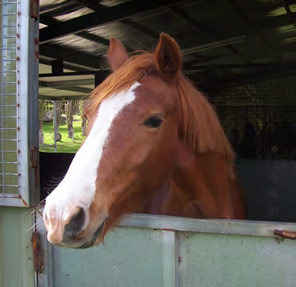Over the stable door
Greetings Fellow Equines and Horse Owners!
Looks like we are heading into a dry autumn, so there will still be snakes about, so do keep your horse areas free of debris, clutter and long grass. Those who are not so good ‘doers’ may start to lose a bit of condition. It pays to keep an eye on this as it may be difficult to get that weight back on once the colder weather hits. For the good ‘doers’ (such as yours truly), this is quite a good time as we can afford to drop that bit of extra without any worries! If ground cover has been reduced so that there are bare patches, and you are hand feeding hay in the paddock, there can be a risk of colic through ingesting sandy soil with bits of hay. A couple of things can help here – put the hay into an ‘off the ground’ feeding rack. or get a large length of industrial rubber sheeting and feed your equine off that. The rubber sheet can also be placed under the feeder. Of course feed will still get spread around, but at least this will minimise your risk. Also feeding your horse on an area of pavers works well too. If it is possible, do this near to his water source, so that hay is not spread around too far as he wanders from food to water.
Rugging
Rugging at this time of year can be tricky too, as the days are still warm, but the nights are definitely getting colder. However, remember the horse is already wearing his own fur coat, and unless he is old or unwell, there is no need to rug just yet. It is when you get the chill factors of wind and rain that the horse can suffer, so although the nights may be getting cold, Autumn is not generally windy, so not a great need to rug. Light rugging does help to keep your neddy clean, but don’t put it on without checking and grooming once a week at the minimum. My new paddock mate had a synthetic rug left on him last winter and was not worked. He still has lumps of old scabs along his back from dried sweat and dirt which are hard to remove without causing him discomfort. The synthetic rugs are great to use, but they can become very warm in moderate weather. Best to keep rugs off whenever practicable.
Back to the float loading/parking!
Doing your homework before asking to perform new tasks will pay off and be less stressful for both of you. It is best done somewhere in his normal work area where he feel safe and secure. Just like us humans, they cannot learn in a stressful situation, so you need as few distractions as possible. Teaching your horse to park is a valuable asset and is an essential part of his education. It can be done with a halter or bridle, an ordinary lead rope or a long western one. Once he is in your quiet area, just have him standing and move away from him a little (this depends on the horse). If he follows you, put him back to the same place. It is easier to do this with a long whip (with a light tap, tap just below the knee) so that you don’t have to move your own feet. As soon as he is back where he started, you must cease the tap. You can gradually increase the distance, or just walk around the horse from both directions. The key is any time he moves, put him back where he was – he will soon get the idea. As you and he get better with this you will be able to move far away from him without him moving. THEN add in your word cue like ’stand’ and he will obey that. Make sure you practise and have patience and end on a good note. Remember to reward with praise and a scratch at the wither (this lowers his heart rate). Now you can go off and put up your jumps or whatever and he can watch! More next time….
Happy munching and safe riding, Hamish

